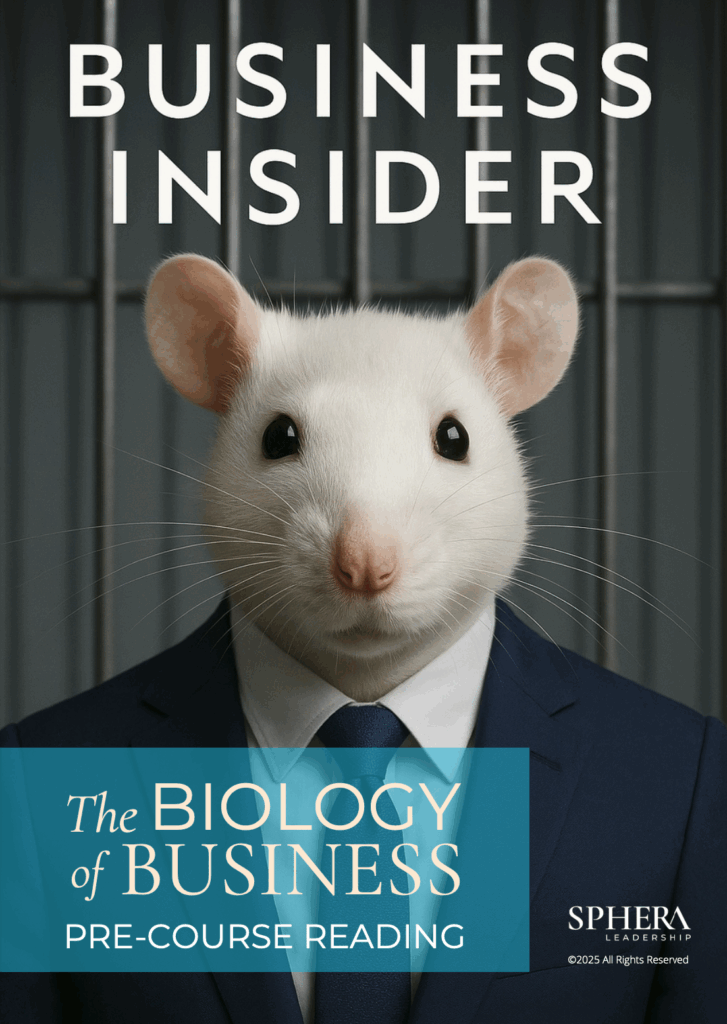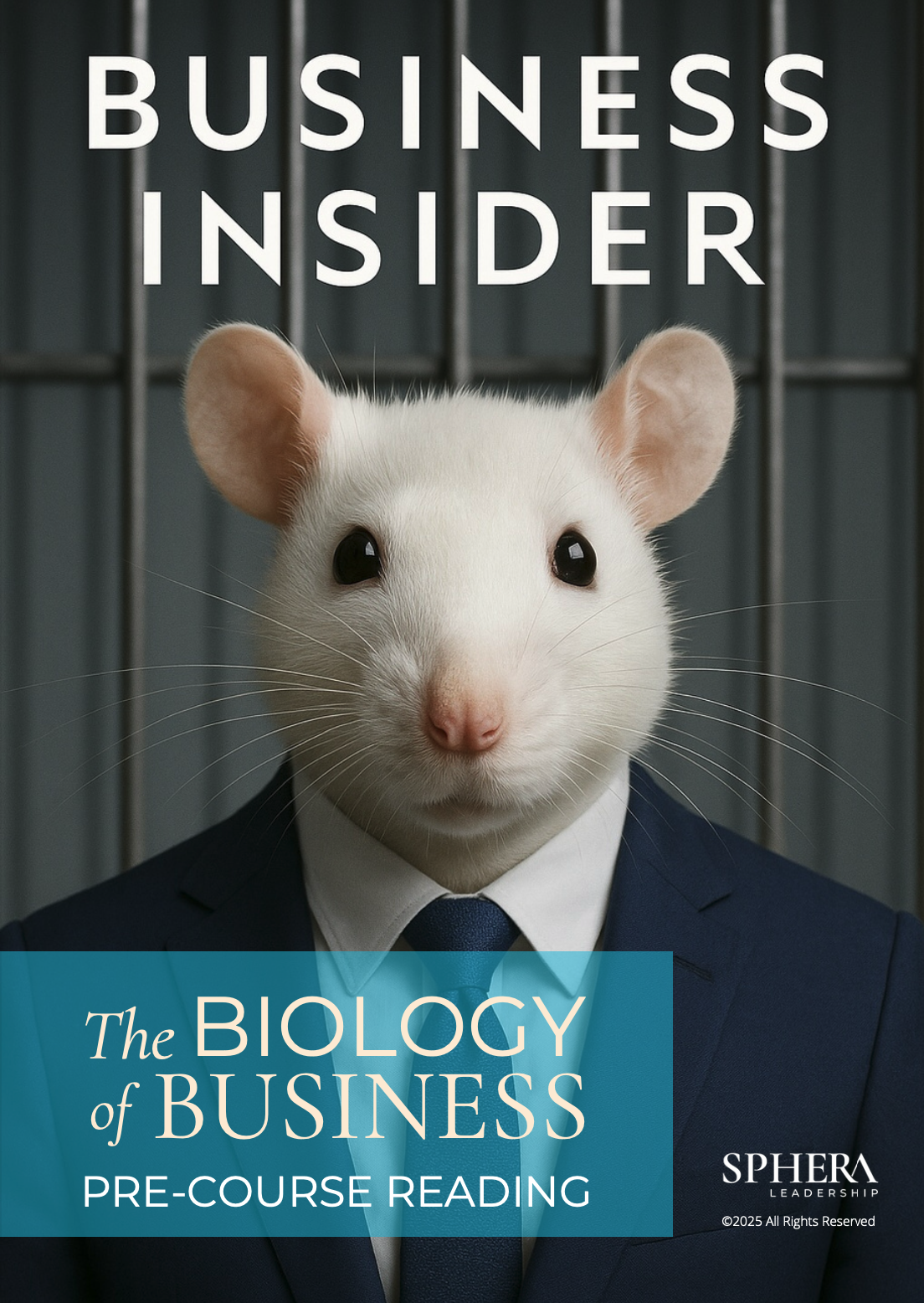
Biology of Business - The Orientation Reflex
The following passages are taken from Maps of Meaning written by Dr. Jordan Peterson: a Canadian clinical psychologist, thinker, and former professor at Harvard and the University of Toronto, who specialized in personality psychology of executives, depression, and the treatment of anxiety through cognitive-behavioral approaches. He is a figure sometimes considered controversial among his colleagues due to his self-criticism of the psychology profession. His books have sold over 14 million copies.

Context and Recommendation for Reading:
This reading points to biological phenomena that govern the emotions, thoughts, and behaviors of animals. Read with the aim of finding parallels and points that you can identify in regards to how you perceive the world, yourself, and those in your organization.
The constant and universal presence of the incomprehensible in the world has elicited adaptive response from us and from all other creatures with highly developed nervous systems. We have evolved to operate successfully in a world eternally composed of the predictable, in paradoxical juxtaposition with the unpredictable. The combination of what we have explored and what we have still to evaluate actually comprises our environment, insofar as its nature can be broadly specified—and it is to that environment that our physiological structure has become matched. One set of the systems that comprise our brain and mind governs activity, when we are guided by our plans—when we are in the domain of the known. Another appears to operate when we face something unexpected— when we have entered the realm of the unknown.
The “limbic unit” generates the orienting reflex, among its other tasks. It is the orienting reflex, which manifests itself in emotion, thought and behavior, that is at the core of the fundamental human response to the novel or unknown. This reflex takes a biologically determined course, ancient in nature, primordial as hunger or thirst, basic as sexuality, extant similarly in the animal kingdom, far down the chain of organic being. The orienting reflex is the general instinctual reaction to the category of all occurrences which have not yet been categorized—is response to the unexpected, novel or unknown per se, and not to any discriminated aspect of experience, any specifically definable situation or thing. The orienting reflex is at the core of the process that generates (conditional) knowledge of sensory phenomena and motivational relevance or valence.
Such knowledge is most fundamentally how to behave, and what to expect as a consequence, in a particular situation, defined by culturally modified external environmental circumstance and equally modified internal motivational state. It is also information about what is, from the objective perspective—is the record of that sensory experience occurring .in the course of ongoing behavior.
Our emotional regulation depends as much (or more) on the stability and predictability of the social environment (on the maintenance of our cultures) as on “interior” processes, classically related to the strength of the ego or the personality. Social order is a necessary precondition for psychological stability: it is primarily our companions and their actions (or inactions) that stabilize or destabilize our emotions.
A rat (a person) is a complacent creature in explored territory. When in unexplored territory, however, it is anything but calm. A rat moved from its home cage to a new and unknown environment—a new cage, for example—will first freeze (even though it has never been punished, in the new situation). If nothing terrible happens to it (nothing punishing, threatening or additionally unpredictable) it will begin to sniff, to look around, to move its head, to gather new information about the intrinsically frightening place it now inhabits. Gradually, it starts to move about. It will explore the whole cage with increasing confidence. It is mapping the new environment for affective valence. It wants to find out: is there anything here that will kill me? Anything here I can eat? Anyone else here—someone hostile or friendly? A potential mate? The rat is interested in determining whether the new place contains anything of determinate interest to a rat, and it explores, to the best of its capacity, to make that judgment. It is not primarily interested in the “objective” nature of the new circumstances—a rat cannot actually determine what is objective and what is merely “personal opinion.” Nor does it care. It just wants to know what it should do.
What happens if an animal encounters something truly unexpected—something that should just not be, according to its current frame of reference or system of belief? The answer to this question sheds substantial light on the nature of the orienting reflex, in its full manifestation. Modern experimental psychologists have begun to examine the response of animals to natural sources of mystery and threat. They allow the animals to set up their own environments, realistic environments, and then expose them to the kinds of surprising circumstances they might encounter in real life.
The appearance of a predator in previously safe space (space previously explored, that is, and mapped as useful or irrelevant) constitutes one type of realistic surprise. Blanchard and colleagues describe the naturalistic behavior of rats, under such conditions:
“When a cat is presented to established mixed-sex groups of laboratory rats living in a visible burrow system, the behaviors of the subjects change dramatically, in many cases for 24 hours or more. The initial active defensive behavior, flight to the tunnel/chamber system, is followed by a period of immobility during which the rats make 22 kHz ultrasonic vocalizations, which apparently serve as alarm cries, at a high rate. As freezing breaks up, proxemic avoidance of the open area gradually gives way to a pattern of “risk assessment” of the area where the cat was encountered. Subjects poke their heads out of the tunnel openings to scan the open area where the cat was presented, for minutes or hours before emerging, and when they do emerge, their locomotory patterns are characterized by [behaviors that theoretically reduce their visibility and vulnerability to predators and by] very short “corner runs” into and out of the open area. These risk assessment activities appear to involve active gathering of information about the possible danger source, providing a basis for a gradual return to nondefensive behaviors. Active risk assessment is not seen during early post-cat exposure, when freezing and avoidance of the open area are the dominant behaviors, but rises to a peak about 7–10 hours later, and then gradually declines. Nondefensive behaviors128 such as eating, drinking and sexual and aggressive activity tend to be reduced over the same period. “
The unexpected appearance of a predator where nothing but defined territory previously existed terrifies the rats—badly enough that they “scream” about it, persistently, for a long period of time. Once this initial terror abates—which occurs only if nothing else horrible or punishing happens—curiosity is disinhibited, and the rats return to the scene of the crime. The space “renovelized” by the fact of the cat has to be transformed once again into explored territory as a consequence of active modification of behavior (and representational schema), not by passive desensitization to the unexpected. The rats run across the territory “contaminated” by the presence of the cat, to find out if anything dangerous (to running rats) still lurks there. If the answer is “no,” then the space is defined, once again, as home territory (which is that place where commonplace behaviors produce desired ends). The rats transform the dangerous unknown into familiar territory as a consequence of voluntary exploration. In the absence of such exploration, terror reigns unchecked.
It is just as illuminating to consider the responses of rats to their kin, who constitute “explored territory,” in contrast to their attitude toward “strangers,” whose behavior is not predictable. Rats are highly social animals, perfectly capable of living with their familiar compatriots in peace. They do not like members of other kin groups, however; they will hunt them down and kill them. Accidental or purposeful intruders are dealt with in the same manner. Rats identify one another by smell. If an experimenter removes a well- loved rat from its familial surroundings, scrubs it down, provides it with a new odor, and returns it to its peers, it will be promptly dispatched by those who once loved it. The “new” rat constitutes “unexplored territory”; his presence is regarded as a threat (not unreasonably) to everything currently secure. Chimpanzees, perfectly capable of killing “foreign devils” (even those who were once familiar), act in much the same manner.
If this article resonated with you, it’s only the tip of the iceberg:
SPHERA trains managers through powerful performance enhancing distinctions as their go-to operating system — not as theory, but as a practical skill that becomes part of how they lead. Reading rarely impacts behavior, but engaging in our experiential workshops that shift paradigms will. If you’re interested in shifting the paradigm in which your team does business, let’s have a conversation to explore how we can launch you and your team into your next sphere of performance.
Reach out to us at:
command@spheraleadership.com
